Evaluating JB Hi-Fi's Reporting with Classical & Stakeholder Theory
VerifiedAdded on 2023/06/11
|22
|6296
|370
Case Study
AI Summary
This case study solution examines JB Hi-Fi's reporting decisions through the lens of classical political economy theory and managerial stakeholder theory. It analyzes the company's decision to release a profit downgrade and its interactions with the Australian Securities Exchange (ASX). The analysis applies classical economic principles to understand JB Hi-Fi's operational strategies and explores how institutional theory explains the company's approach to external factors. Furthermore, the solution uses managerial stakeholder theory to interpret JB Hi-Fi's reporting choices, focusing on how the company prioritizes stakeholder relationships and manages expectations. The case study provides insights into the complexities of corporate reporting and the influence of economic theories on business decisions, referencing relevant academic sources to support its arguments.
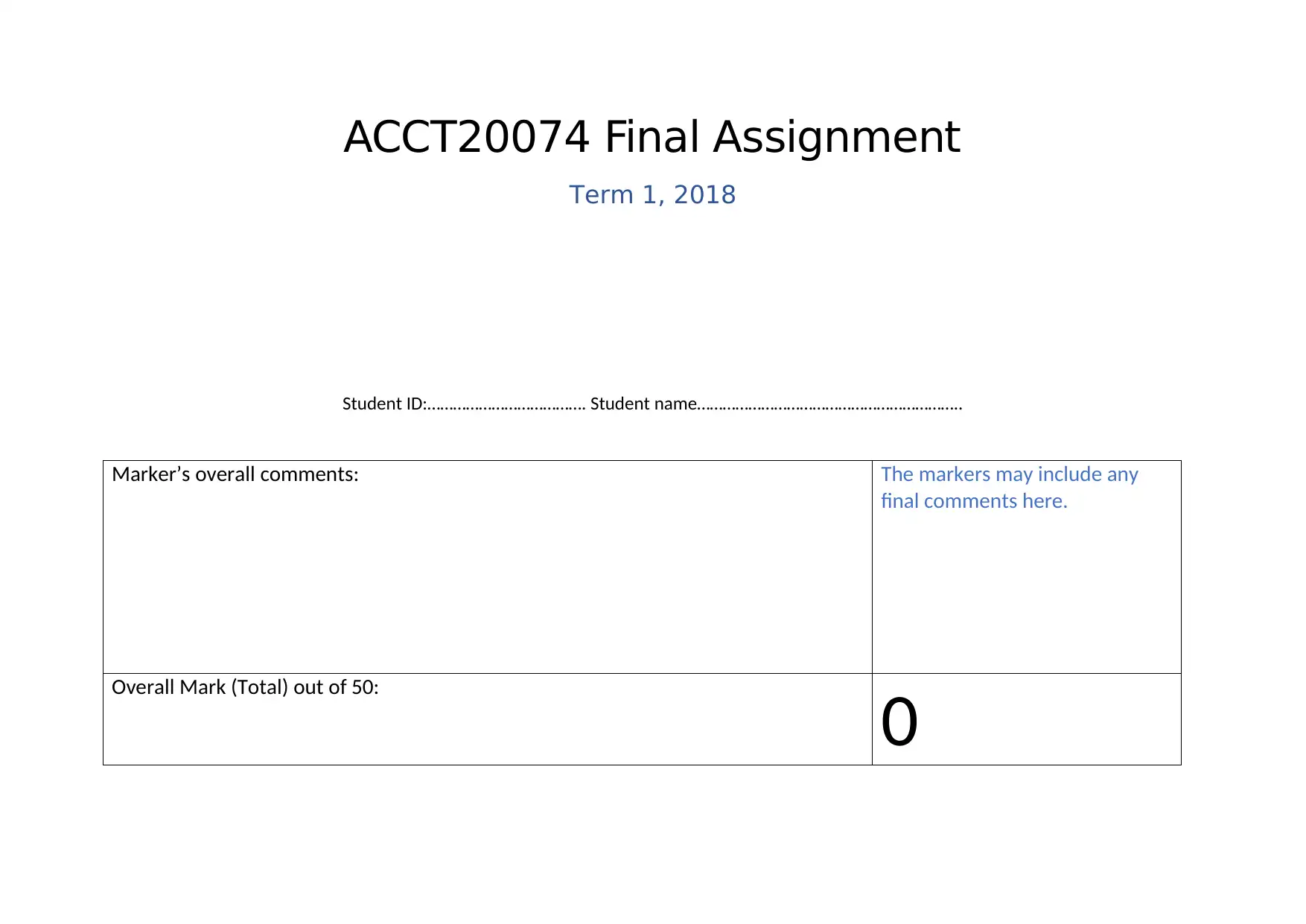
ACCT20074 Final Assignment
Term 1, 2018
Student ID:………………………………. Student name……………………………………………………..
Marker’s overall comments: The markers may include any
final comments here.
Overall Mark (Total) out of 50:
0
Term 1, 2018
Student ID:………………………………. Student name……………………………………………………..
Marker’s overall comments: The markers may include any
final comments here.
Overall Mark (Total) out of 50:
0
Paraphrase This Document
Need a fresh take? Get an instant paraphrase of this document with our AI Paraphraser
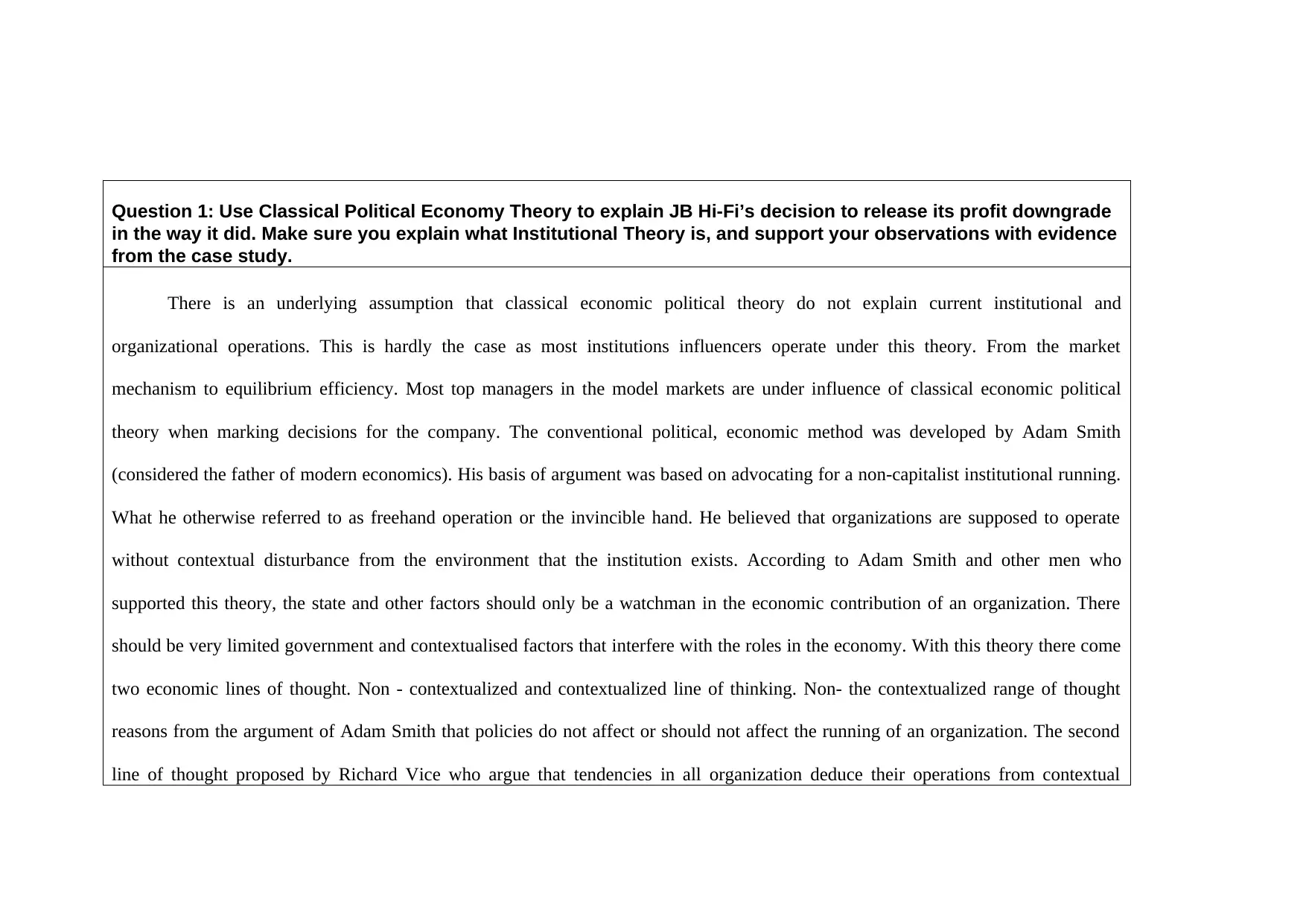
Question 1: Use Classical Political Economy Theory to explain JB Hi-Fi’s decision to release its profit downgrade
in the way it did. Make sure you explain what Institutional Theory is, and support your observations with evidence
from the case study.
There is an underlying assumption that classical economic political theory do not explain current institutional and
organizational operations. This is hardly the case as most institutions influencers operate under this theory. From the market
mechanism to equilibrium efficiency. Most top managers in the model markets are under influence of classical economic political
theory when marking decisions for the company. The conventional political, economic method was developed by Adam Smith
(considered the father of modern economics). His basis of argument was based on advocating for a non-capitalist institutional running.
What he otherwise referred to as freehand operation or the invincible hand. He believed that organizations are supposed to operate
without contextual disturbance from the environment that the institution exists. According to Adam Smith and other men who
supported this theory, the state and other factors should only be a watchman in the economic contribution of an organization. There
should be very limited government and contextualised factors that interfere with the roles in the economy. With this theory there come
two economic lines of thought. Non - contextualized and contextualized line of thinking. Non- the contextualized range of thought
reasons from the argument of Adam Smith that policies do not affect or should not affect the running of an organization. The second
line of thought proposed by Richard Vice who argue that tendencies in all organization deduce their operations from contextual
in the way it did. Make sure you explain what Institutional Theory is, and support your observations with evidence
from the case study.
There is an underlying assumption that classical economic political theory do not explain current institutional and
organizational operations. This is hardly the case as most institutions influencers operate under this theory. From the market
mechanism to equilibrium efficiency. Most top managers in the model markets are under influence of classical economic political
theory when marking decisions for the company. The conventional political, economic method was developed by Adam Smith
(considered the father of modern economics). His basis of argument was based on advocating for a non-capitalist institutional running.
What he otherwise referred to as freehand operation or the invincible hand. He believed that organizations are supposed to operate
without contextual disturbance from the environment that the institution exists. According to Adam Smith and other men who
supported this theory, the state and other factors should only be a watchman in the economic contribution of an organization. There
should be very limited government and contextualised factors that interfere with the roles in the economy. With this theory there come
two economic lines of thought. Non - contextualized and contextualized line of thinking. Non- the contextualized range of thought
reasons from the argument of Adam Smith that policies do not affect or should not affect the running of an organization. The second
line of thought proposed by Richard Vice who argue that tendencies in all organization deduce their operations from contextual
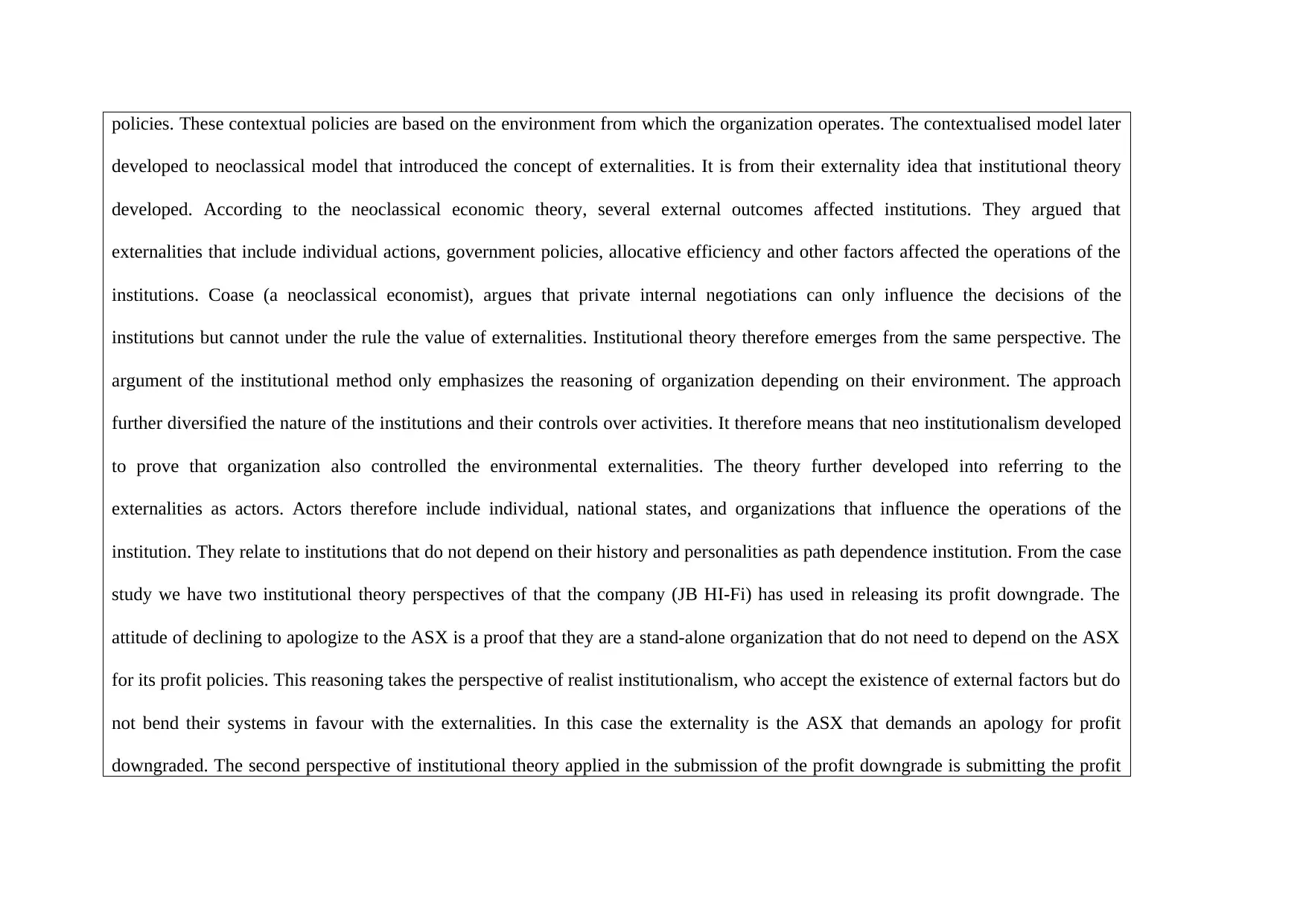
policies. These contextual policies are based on the environment from which the organization operates. The contextualised model later
developed to neoclassical model that introduced the concept of externalities. It is from their externality idea that institutional theory
developed. According to the neoclassical economic theory, several external outcomes affected institutions. They argued that
externalities that include individual actions, government policies, allocative efficiency and other factors affected the operations of the
institutions. Coase (a neoclassical economist), argues that private internal negotiations can only influence the decisions of the
institutions but cannot under the rule the value of externalities. Institutional theory therefore emerges from the same perspective. The
argument of the institutional method only emphasizes the reasoning of organization depending on their environment. The approach
further diversified the nature of the institutions and their controls over activities. It therefore means that neo institutionalism developed
to prove that organization also controlled the environmental externalities. The theory further developed into referring to the
externalities as actors. Actors therefore include individual, national states, and organizations that influence the operations of the
institution. They relate to institutions that do not depend on their history and personalities as path dependence institution. From the case
study we have two institutional theory perspectives of that the company (JB HI-Fi) has used in releasing its profit downgrade. The
attitude of declining to apologize to the ASX is a proof that they are a stand-alone organization that do not need to depend on the ASX
for its profit policies. This reasoning takes the perspective of realist institutionalism, who accept the existence of external factors but do
not bend their systems in favour with the externalities. In this case the externality is the ASX that demands an apology for profit
downgraded. The second perspective of institutional theory applied in the submission of the profit downgrade is submitting the profit
developed to neoclassical model that introduced the concept of externalities. It is from their externality idea that institutional theory
developed. According to the neoclassical economic theory, several external outcomes affected institutions. They argued that
externalities that include individual actions, government policies, allocative efficiency and other factors affected the operations of the
institutions. Coase (a neoclassical economist), argues that private internal negotiations can only influence the decisions of the
institutions but cannot under the rule the value of externalities. Institutional theory therefore emerges from the same perspective. The
argument of the institutional method only emphasizes the reasoning of organization depending on their environment. The approach
further diversified the nature of the institutions and their controls over activities. It therefore means that neo institutionalism developed
to prove that organization also controlled the environmental externalities. The theory further developed into referring to the
externalities as actors. Actors therefore include individual, national states, and organizations that influence the operations of the
institution. They relate to institutions that do not depend on their history and personalities as path dependence institution. From the case
study we have two institutional theory perspectives of that the company (JB HI-Fi) has used in releasing its profit downgrade. The
attitude of declining to apologize to the ASX is a proof that they are a stand-alone organization that do not need to depend on the ASX
for its profit policies. This reasoning takes the perspective of realist institutionalism, who accept the existence of external factors but do
not bend their systems in favour with the externalities. In this case the externality is the ASX that demands an apology for profit
downgraded. The second perspective of institutional theory applied in the submission of the profit downgrade is submitting the profit
⊘ This is a preview!⊘
Do you want full access?
Subscribe today to unlock all pages.

Trusted by 1+ million students worldwide
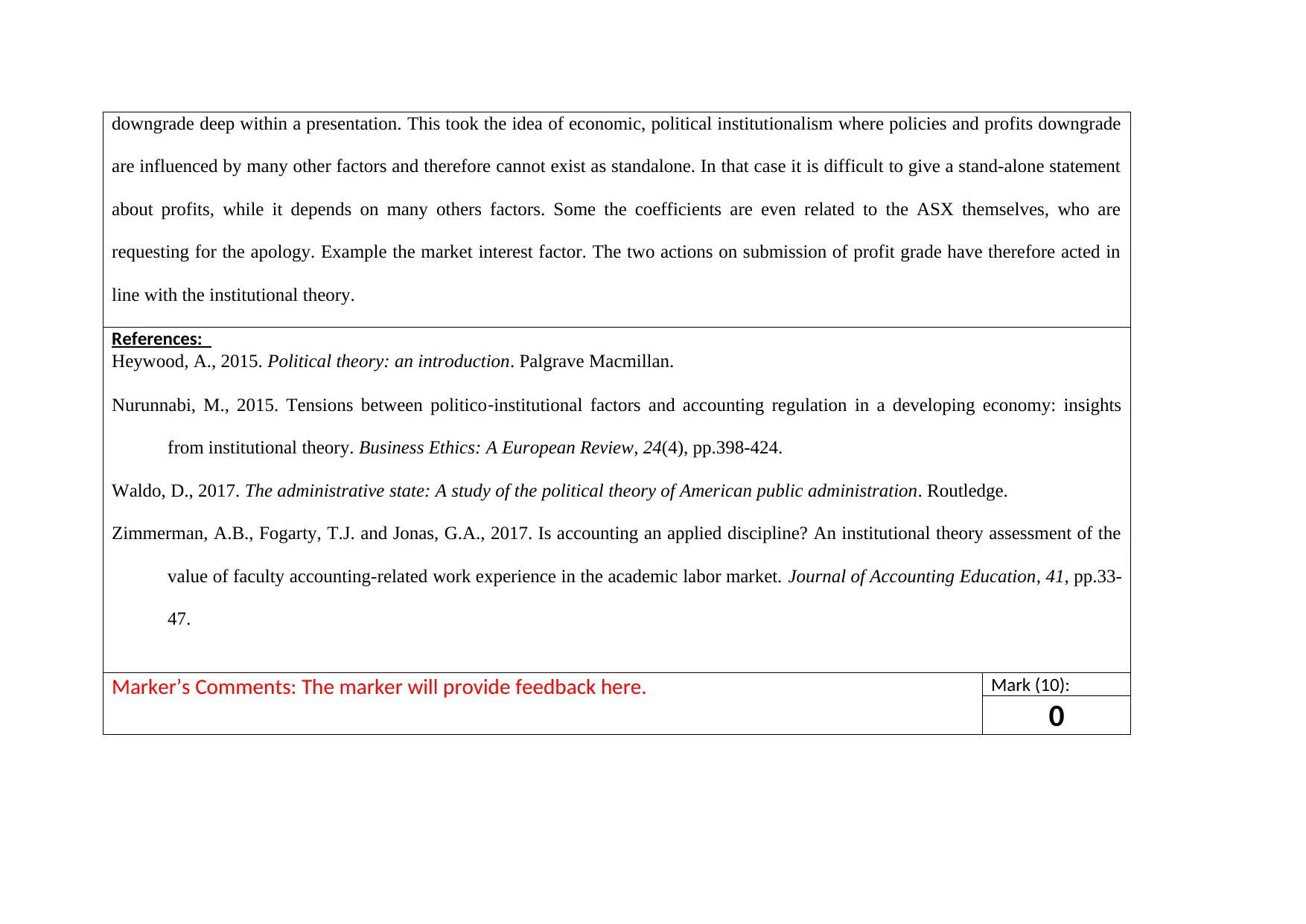
downgrade deep within a presentation. This took the idea of economic, political institutionalism where policies and profits downgrade
are influenced by many other factors and therefore cannot exist as standalone. In that case it is difficult to give a stand-alone statement
about profits, while it depends on many others factors. Some the coefficients are even related to the ASX themselves, who are
requesting for the apology. Example the market interest factor. The two actions on submission of profit grade have therefore acted in
line with the institutional theory.
References:
Heywood, A., 2015. Political theory: an introduction. Palgrave Macmillan.
Nurunnabi, M., 2015. Tensions between politico‐institutional factors and accounting regulation in a developing economy: insights
from institutional theory. Business Ethics: A European Review, 24(4), pp.398-424.
Waldo, D., 2017. The administrative state: A study of the political theory of American public administration. Routledge.
Zimmerman, A.B., Fogarty, T.J. and Jonas, G.A., 2017. Is accounting an applied discipline? An institutional theory assessment of the
value of faculty accounting-related work experience in the academic labor market. Journal of Accounting Education, 41, pp.33-
47.
Marker’s Comments: The marker will provide feedback here. Mark (10):
0
are influenced by many other factors and therefore cannot exist as standalone. In that case it is difficult to give a stand-alone statement
about profits, while it depends on many others factors. Some the coefficients are even related to the ASX themselves, who are
requesting for the apology. Example the market interest factor. The two actions on submission of profit grade have therefore acted in
line with the institutional theory.
References:
Heywood, A., 2015. Political theory: an introduction. Palgrave Macmillan.
Nurunnabi, M., 2015. Tensions between politico‐institutional factors and accounting regulation in a developing economy: insights
from institutional theory. Business Ethics: A European Review, 24(4), pp.398-424.
Waldo, D., 2017. The administrative state: A study of the political theory of American public administration. Routledge.
Zimmerman, A.B., Fogarty, T.J. and Jonas, G.A., 2017. Is accounting an applied discipline? An institutional theory assessment of the
value of faculty accounting-related work experience in the academic labor market. Journal of Accounting Education, 41, pp.33-
47.
Marker’s Comments: The marker will provide feedback here. Mark (10):
0
Paraphrase This Document
Need a fresh take? Get an instant paraphrase of this document with our AI Paraphraser
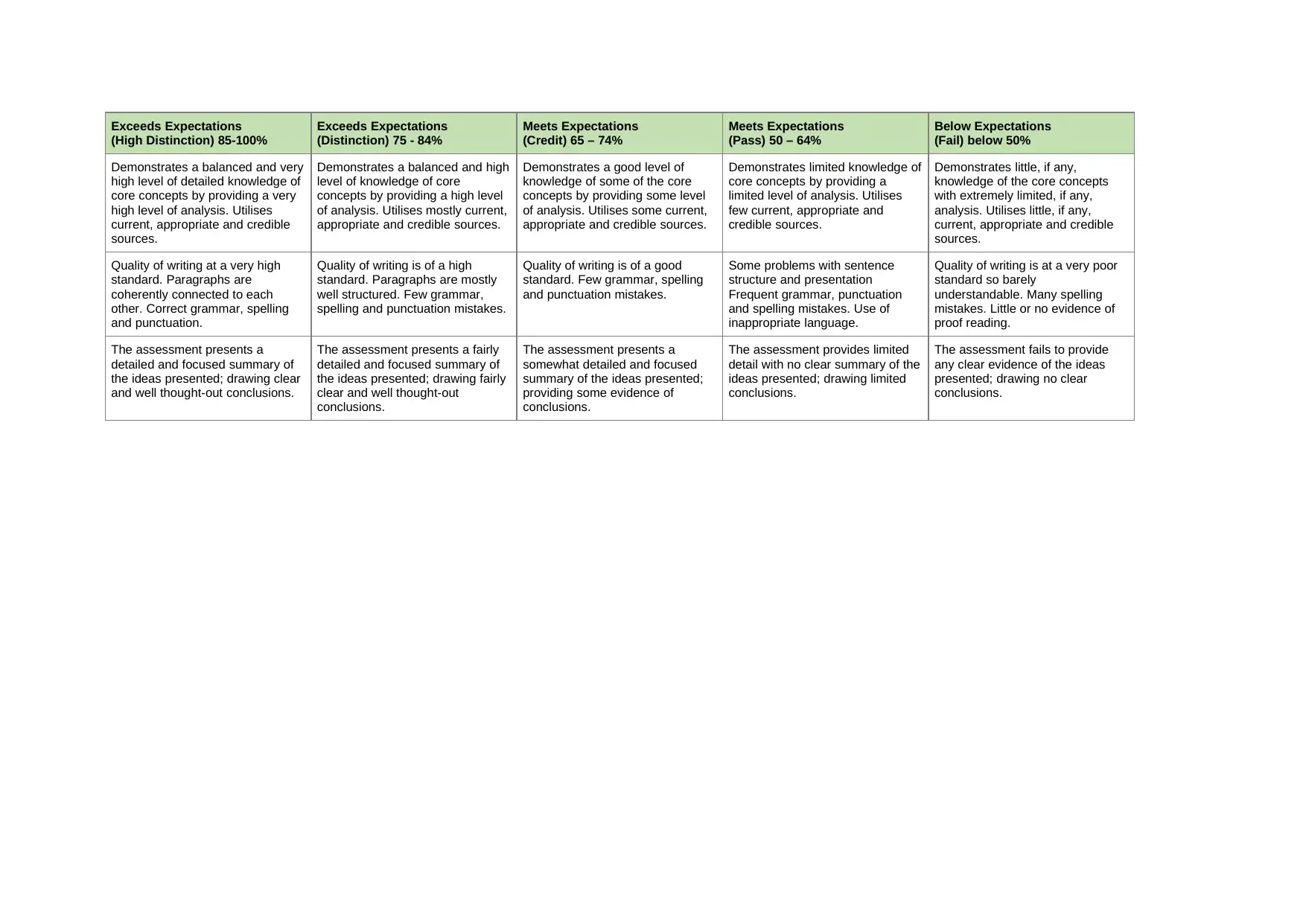
Exceeds Expectations
(High Distinction) 85-100%
Exceeds Expectations
(Distinction) 75 - 84%
Meets Expectations
(Credit) 65 – 74%
Meets Expectations
(Pass) 50 – 64%
Below Expectations
(Fail) below 50%
Demonstrates a balanced and very
high level of detailed knowledge of
core concepts by providing a very
high level of analysis. Utilises
current, appropriate and credible
sources.
Demonstrates a balanced and high
level of knowledge of core
concepts by providing a high level
of analysis. Utilises mostly current,
appropriate and credible sources.
Demonstrates a good level of
knowledge of some of the core
concepts by providing some level
of analysis. Utilises some current,
appropriate and credible sources.
Demonstrates limited knowledge of
core concepts by providing a
limited level of analysis. Utilises
few current, appropriate and
credible sources.
Demonstrates little, if any,
knowledge of the core concepts
with extremely limited, if any,
analysis. Utilises little, if any,
current, appropriate and credible
sources.
Quality of writing at a very high
standard. Paragraphs are
coherently connected to each
other. Correct grammar, spelling
and punctuation.
Quality of writing is of a high
standard. Paragraphs are mostly
well structured. Few grammar,
spelling and punctuation mistakes.
Quality of writing is of a good
standard. Few grammar, spelling
and punctuation mistakes.
Some problems with sentence
structure and presentation
Frequent grammar, punctuation
and spelling mistakes. Use of
inappropriate language.
Quality of writing is at a very poor
standard so barely
understandable. Many spelling
mistakes. Little or no evidence of
proof reading.
The assessment presents a
detailed and focused summary of
the ideas presented; drawing clear
and well thought-out conclusions.
The assessment presents a fairly
detailed and focused summary of
the ideas presented; drawing fairly
clear and well thought-out
conclusions.
The assessment presents a
somewhat detailed and focused
summary of the ideas presented;
providing some evidence of
conclusions.
The assessment provides limited
detail with no clear summary of the
ideas presented; drawing limited
conclusions.
The assessment fails to provide
any clear evidence of the ideas
presented; drawing no clear
conclusions.
(High Distinction) 85-100%
Exceeds Expectations
(Distinction) 75 - 84%
Meets Expectations
(Credit) 65 – 74%
Meets Expectations
(Pass) 50 – 64%
Below Expectations
(Fail) below 50%
Demonstrates a balanced and very
high level of detailed knowledge of
core concepts by providing a very
high level of analysis. Utilises
current, appropriate and credible
sources.
Demonstrates a balanced and high
level of knowledge of core
concepts by providing a high level
of analysis. Utilises mostly current,
appropriate and credible sources.
Demonstrates a good level of
knowledge of some of the core
concepts by providing some level
of analysis. Utilises some current,
appropriate and credible sources.
Demonstrates limited knowledge of
core concepts by providing a
limited level of analysis. Utilises
few current, appropriate and
credible sources.
Demonstrates little, if any,
knowledge of the core concepts
with extremely limited, if any,
analysis. Utilises little, if any,
current, appropriate and credible
sources.
Quality of writing at a very high
standard. Paragraphs are
coherently connected to each
other. Correct grammar, spelling
and punctuation.
Quality of writing is of a high
standard. Paragraphs are mostly
well structured. Few grammar,
spelling and punctuation mistakes.
Quality of writing is of a good
standard. Few grammar, spelling
and punctuation mistakes.
Some problems with sentence
structure and presentation
Frequent grammar, punctuation
and spelling mistakes. Use of
inappropriate language.
Quality of writing is at a very poor
standard so barely
understandable. Many spelling
mistakes. Little or no evidence of
proof reading.
The assessment presents a
detailed and focused summary of
the ideas presented; drawing clear
and well thought-out conclusions.
The assessment presents a fairly
detailed and focused summary of
the ideas presented; drawing fairly
clear and well thought-out
conclusions.
The assessment presents a
somewhat detailed and focused
summary of the ideas presented;
providing some evidence of
conclusions.
The assessment provides limited
detail with no clear summary of the
ideas presented; drawing limited
conclusions.
The assessment fails to provide
any clear evidence of the ideas
presented; drawing no clear
conclusions.
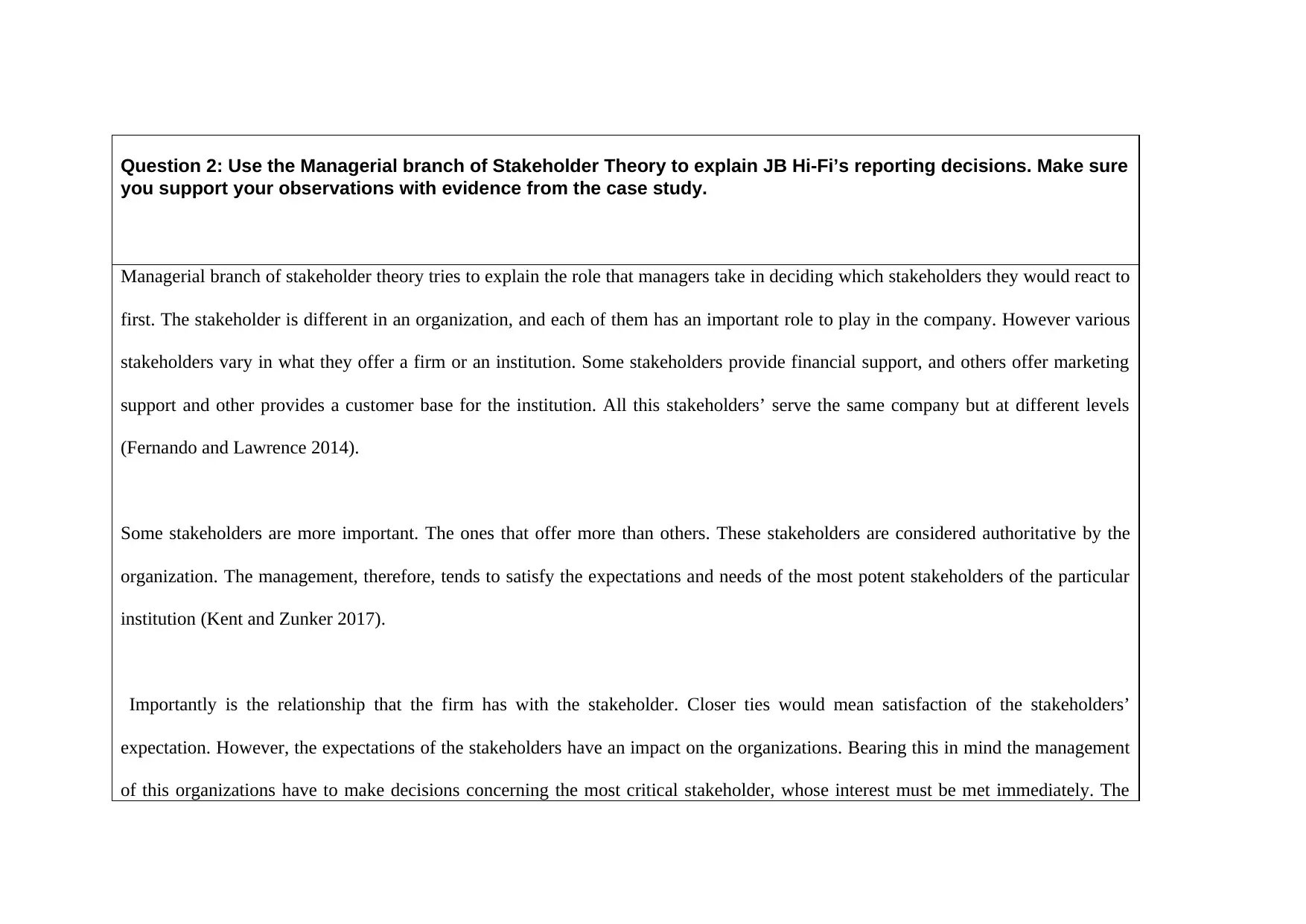
Question 2: Use the Managerial branch of Stakeholder Theory to explain JB Hi-Fi’s reporting decisions. Make sure
you support your observations with evidence from the case study.
Managerial branch of stakeholder theory tries to explain the role that managers take in deciding which stakeholders they would react to
first. The stakeholder is different in an organization, and each of them has an important role to play in the company. However various
stakeholders vary in what they offer a firm or an institution. Some stakeholders provide financial support, and others offer marketing
support and other provides a customer base for the institution. All this stakeholders’ serve the same company but at different levels
(Fernando and Lawrence 2014).
Some stakeholders are more important. The ones that offer more than others. These stakeholders are considered authoritative by the
organization. The management, therefore, tends to satisfy the expectations and needs of the most potent stakeholders of the particular
institution (Kent and Zunker 2017).
Importantly is the relationship that the firm has with the stakeholder. Closer ties would mean satisfaction of the stakeholders’
expectation. However, the expectations of the stakeholders have an impact on the organizations. Bearing this in mind the management
of this organizations have to make decisions concerning the most critical stakeholder, whose interest must be met immediately. The
you support your observations with evidence from the case study.
Managerial branch of stakeholder theory tries to explain the role that managers take in deciding which stakeholders they would react to
first. The stakeholder is different in an organization, and each of them has an important role to play in the company. However various
stakeholders vary in what they offer a firm or an institution. Some stakeholders provide financial support, and others offer marketing
support and other provides a customer base for the institution. All this stakeholders’ serve the same company but at different levels
(Fernando and Lawrence 2014).
Some stakeholders are more important. The ones that offer more than others. These stakeholders are considered authoritative by the
organization. The management, therefore, tends to satisfy the expectations and needs of the most potent stakeholders of the particular
institution (Kent and Zunker 2017).
Importantly is the relationship that the firm has with the stakeholder. Closer ties would mean satisfaction of the stakeholders’
expectation. However, the expectations of the stakeholders have an impact on the organizations. Bearing this in mind the management
of this organizations have to make decisions concerning the most critical stakeholder, whose interest must be met immediately. The
⊘ This is a preview!⊘
Do you want full access?
Subscribe today to unlock all pages.

Trusted by 1+ million students worldwide
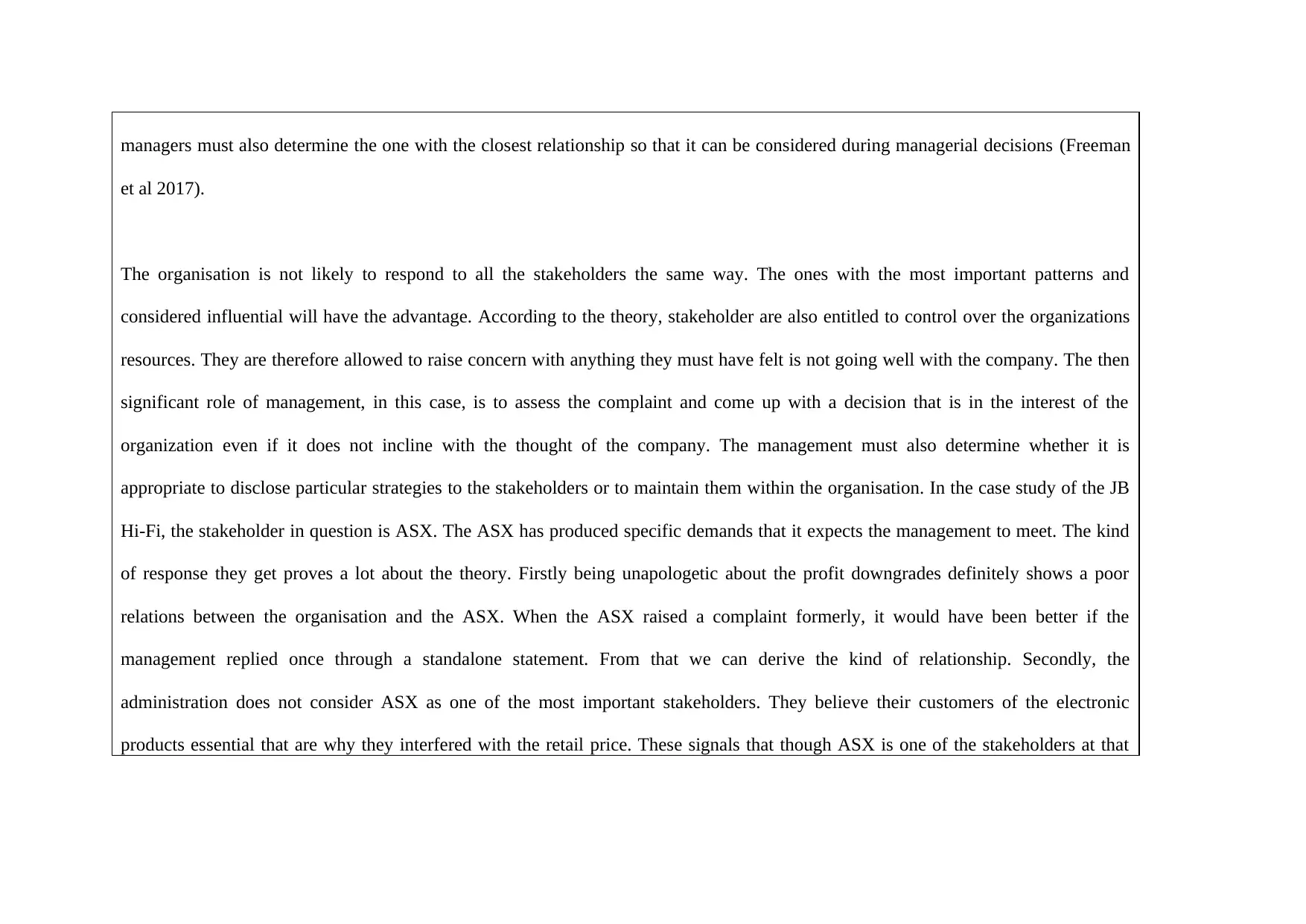
managers must also determine the one with the closest relationship so that it can be considered during managerial decisions (Freeman
et al 2017).
The organisation is not likely to respond to all the stakeholders the same way. The ones with the most important patterns and
considered influential will have the advantage. According to the theory, stakeholder are also entitled to control over the organizations
resources. They are therefore allowed to raise concern with anything they must have felt is not going well with the company. The then
significant role of management, in this case, is to assess the complaint and come up with a decision that is in the interest of the
organization even if it does not incline with the thought of the company. The management must also determine whether it is
appropriate to disclose particular strategies to the stakeholders or to maintain them within the organisation. In the case study of the JB
Hi-Fi, the stakeholder in question is ASX. The ASX has produced specific demands that it expects the management to meet. The kind
of response they get proves a lot about the theory. Firstly being unapologetic about the profit downgrades definitely shows a poor
relations between the organisation and the ASX. When the ASX raised a complaint formerly, it would have been better if the
management replied once through a standalone statement. From that we can derive the kind of relationship. Secondly, the
administration does not consider ASX as one of the most important stakeholders. They believe their customers of the electronic
products essential that are why they interfered with the retail price. These signals that though ASX is one of the stakeholders at that
et al 2017).
The organisation is not likely to respond to all the stakeholders the same way. The ones with the most important patterns and
considered influential will have the advantage. According to the theory, stakeholder are also entitled to control over the organizations
resources. They are therefore allowed to raise concern with anything they must have felt is not going well with the company. The then
significant role of management, in this case, is to assess the complaint and come up with a decision that is in the interest of the
organization even if it does not incline with the thought of the company. The management must also determine whether it is
appropriate to disclose particular strategies to the stakeholders or to maintain them within the organisation. In the case study of the JB
Hi-Fi, the stakeholder in question is ASX. The ASX has produced specific demands that it expects the management to meet. The kind
of response they get proves a lot about the theory. Firstly being unapologetic about the profit downgrades definitely shows a poor
relations between the organisation and the ASX. When the ASX raised a complaint formerly, it would have been better if the
management replied once through a standalone statement. From that we can derive the kind of relationship. Secondly, the
administration does not consider ASX as one of the most important stakeholders. They believe their customers of the electronic
products essential that are why they interfered with the retail price. These signals that though ASX is one of the stakeholders at that
Paraphrase This Document
Need a fresh take? Get an instant paraphrase of this document with our AI Paraphraser
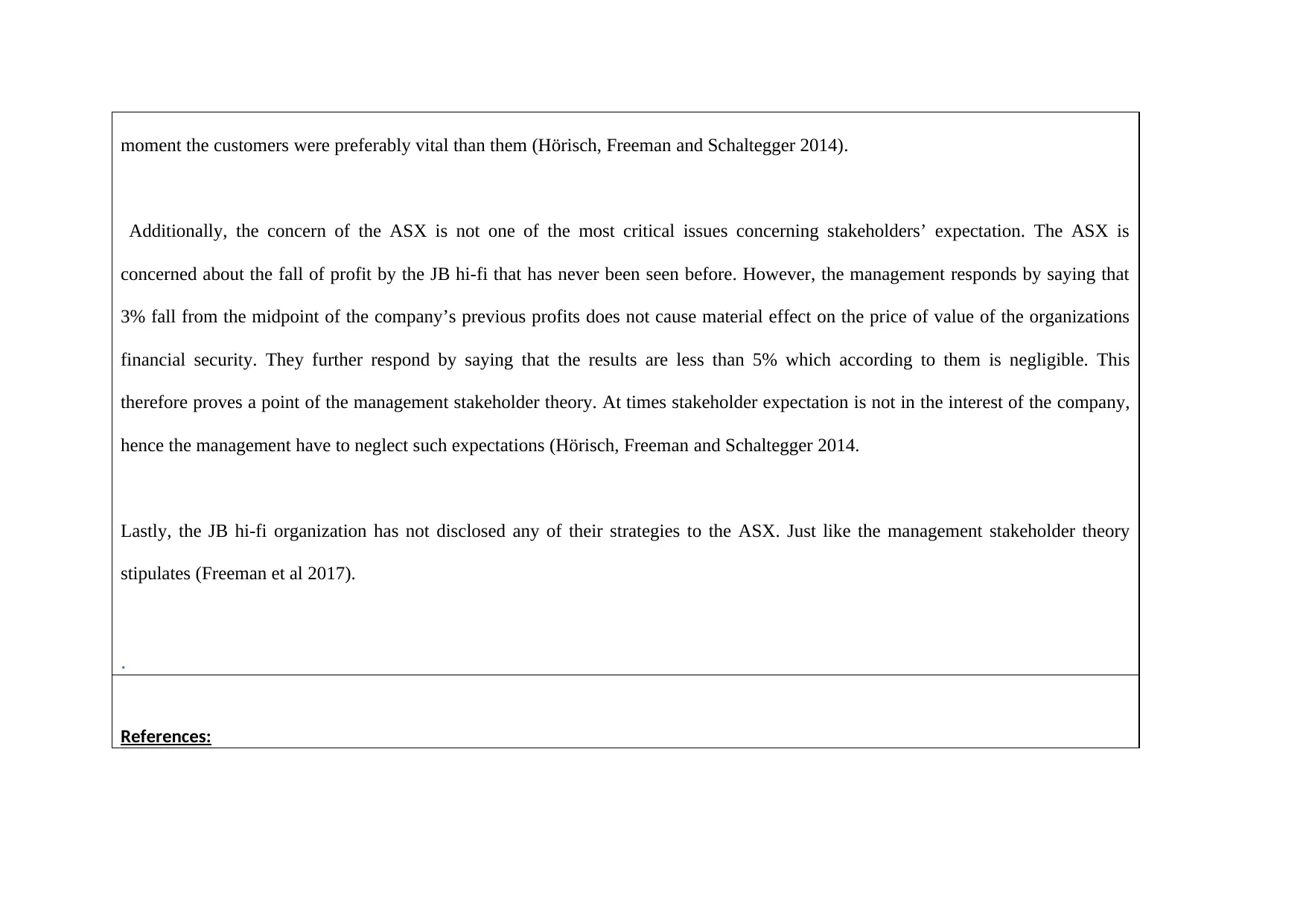
moment the customers were preferably vital than them (Hörisch, Freeman and Schaltegger 2014).
Additionally, the concern of the ASX is not one of the most critical issues concerning stakeholders’ expectation. The ASX is
concerned about the fall of profit by the JB hi-fi that has never been seen before. However, the management responds by saying that
3% fall from the midpoint of the company’s previous profits does not cause material effect on the price of value of the organizations
financial security. They further respond by saying that the results are less than 5% which according to them is negligible. This
therefore proves a point of the management stakeholder theory. At times stakeholder expectation is not in the interest of the company,
hence the management have to neglect such expectations (Hörisch, Freeman and Schaltegger 2014.
Lastly, the JB hi-fi organization has not disclosed any of their strategies to the ASX. Just like the management stakeholder theory
stipulates (Freeman et al 2017).
.
References:
Additionally, the concern of the ASX is not one of the most critical issues concerning stakeholders’ expectation. The ASX is
concerned about the fall of profit by the JB hi-fi that has never been seen before. However, the management responds by saying that
3% fall from the midpoint of the company’s previous profits does not cause material effect on the price of value of the organizations
financial security. They further respond by saying that the results are less than 5% which according to them is negligible. This
therefore proves a point of the management stakeholder theory. At times stakeholder expectation is not in the interest of the company,
hence the management have to neglect such expectations (Hörisch, Freeman and Schaltegger 2014.
Lastly, the JB hi-fi organization has not disclosed any of their strategies to the ASX. Just like the management stakeholder theory
stipulates (Freeman et al 2017).
.
References:
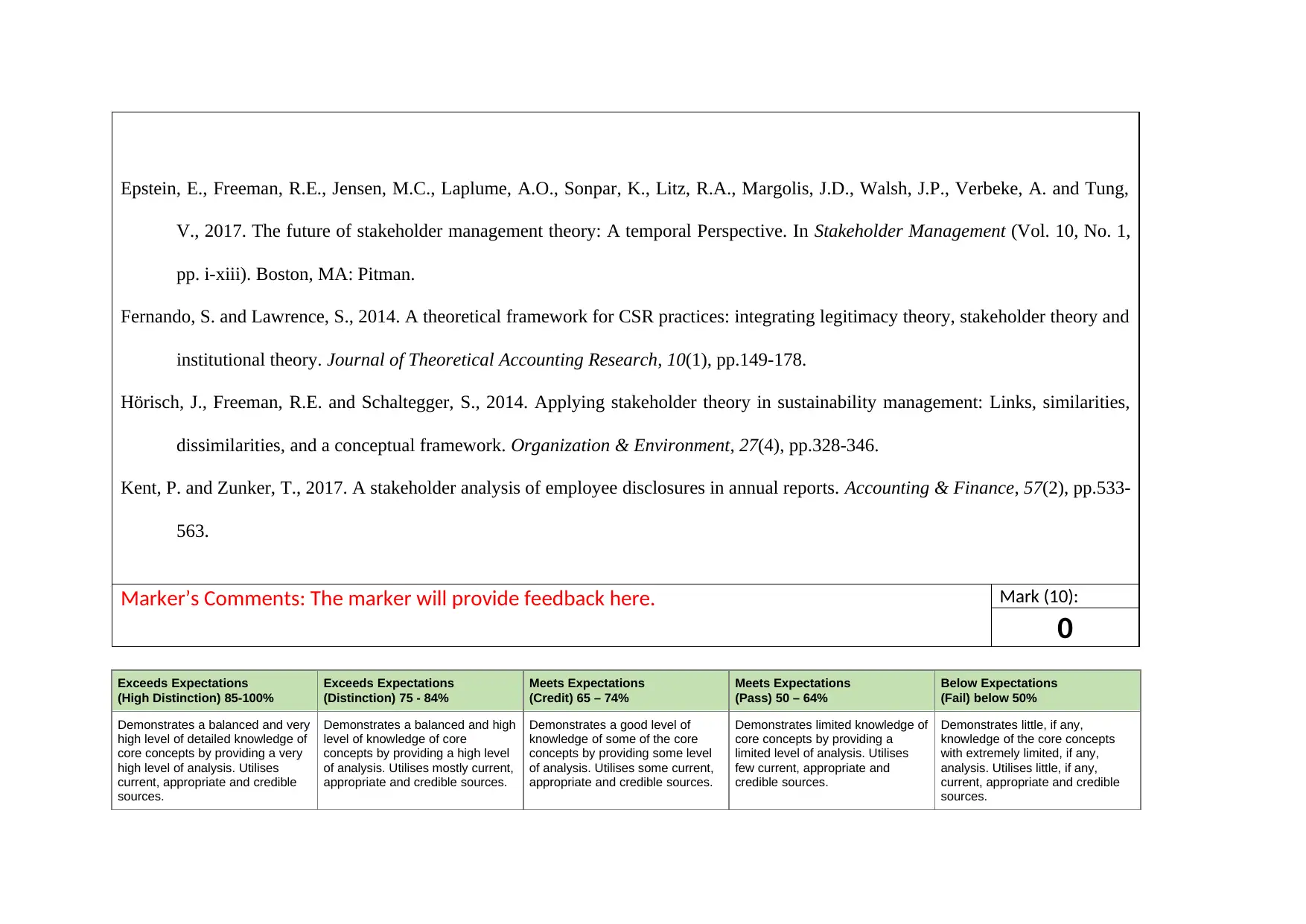
Epstein, E., Freeman, R.E., Jensen, M.C., Laplume, A.O., Sonpar, K., Litz, R.A., Margolis, J.D., Walsh, J.P., Verbeke, A. and Tung,
V., 2017. The future of stakeholder management theory: A temporal Perspective. In Stakeholder Management (Vol. 10, No. 1,
pp. i-xiii). Boston, MA: Pitman.
Fernando, S. and Lawrence, S., 2014. A theoretical framework for CSR practices: integrating legitimacy theory, stakeholder theory and
institutional theory. Journal of Theoretical Accounting Research, 10(1), pp.149-178.
Hörisch, J., Freeman, R.E. and Schaltegger, S., 2014. Applying stakeholder theory in sustainability management: Links, similarities,
dissimilarities, and a conceptual framework. Organization & Environment, 27(4), pp.328-346.
Kent, P. and Zunker, T., 2017. A stakeholder analysis of employee disclosures in annual reports. Accounting & Finance, 57(2), pp.533-
563.
Marker’s Comments: The marker will provide feedback here. Mark (10):
0
Exceeds Expectations
(High Distinction) 85-100%
Exceeds Expectations
(Distinction) 75 - 84%
Meets Expectations
(Credit) 65 – 74%
Meets Expectations
(Pass) 50 – 64%
Below Expectations
(Fail) below 50%
Demonstrates a balanced and very
high level of detailed knowledge of
core concepts by providing a very
high level of analysis. Utilises
current, appropriate and credible
sources.
Demonstrates a balanced and high
level of knowledge of core
concepts by providing a high level
of analysis. Utilises mostly current,
appropriate and credible sources.
Demonstrates a good level of
knowledge of some of the core
concepts by providing some level
of analysis. Utilises some current,
appropriate and credible sources.
Demonstrates limited knowledge of
core concepts by providing a
limited level of analysis. Utilises
few current, appropriate and
credible sources.
Demonstrates little, if any,
knowledge of the core concepts
with extremely limited, if any,
analysis. Utilises little, if any,
current, appropriate and credible
sources.
V., 2017. The future of stakeholder management theory: A temporal Perspective. In Stakeholder Management (Vol. 10, No. 1,
pp. i-xiii). Boston, MA: Pitman.
Fernando, S. and Lawrence, S., 2014. A theoretical framework for CSR practices: integrating legitimacy theory, stakeholder theory and
institutional theory. Journal of Theoretical Accounting Research, 10(1), pp.149-178.
Hörisch, J., Freeman, R.E. and Schaltegger, S., 2014. Applying stakeholder theory in sustainability management: Links, similarities,
dissimilarities, and a conceptual framework. Organization & Environment, 27(4), pp.328-346.
Kent, P. and Zunker, T., 2017. A stakeholder analysis of employee disclosures in annual reports. Accounting & Finance, 57(2), pp.533-
563.
Marker’s Comments: The marker will provide feedback here. Mark (10):
0
Exceeds Expectations
(High Distinction) 85-100%
Exceeds Expectations
(Distinction) 75 - 84%
Meets Expectations
(Credit) 65 – 74%
Meets Expectations
(Pass) 50 – 64%
Below Expectations
(Fail) below 50%
Demonstrates a balanced and very
high level of detailed knowledge of
core concepts by providing a very
high level of analysis. Utilises
current, appropriate and credible
sources.
Demonstrates a balanced and high
level of knowledge of core
concepts by providing a high level
of analysis. Utilises mostly current,
appropriate and credible sources.
Demonstrates a good level of
knowledge of some of the core
concepts by providing some level
of analysis. Utilises some current,
appropriate and credible sources.
Demonstrates limited knowledge of
core concepts by providing a
limited level of analysis. Utilises
few current, appropriate and
credible sources.
Demonstrates little, if any,
knowledge of the core concepts
with extremely limited, if any,
analysis. Utilises little, if any,
current, appropriate and credible
sources.
⊘ This is a preview!⊘
Do you want full access?
Subscribe today to unlock all pages.

Trusted by 1+ million students worldwide
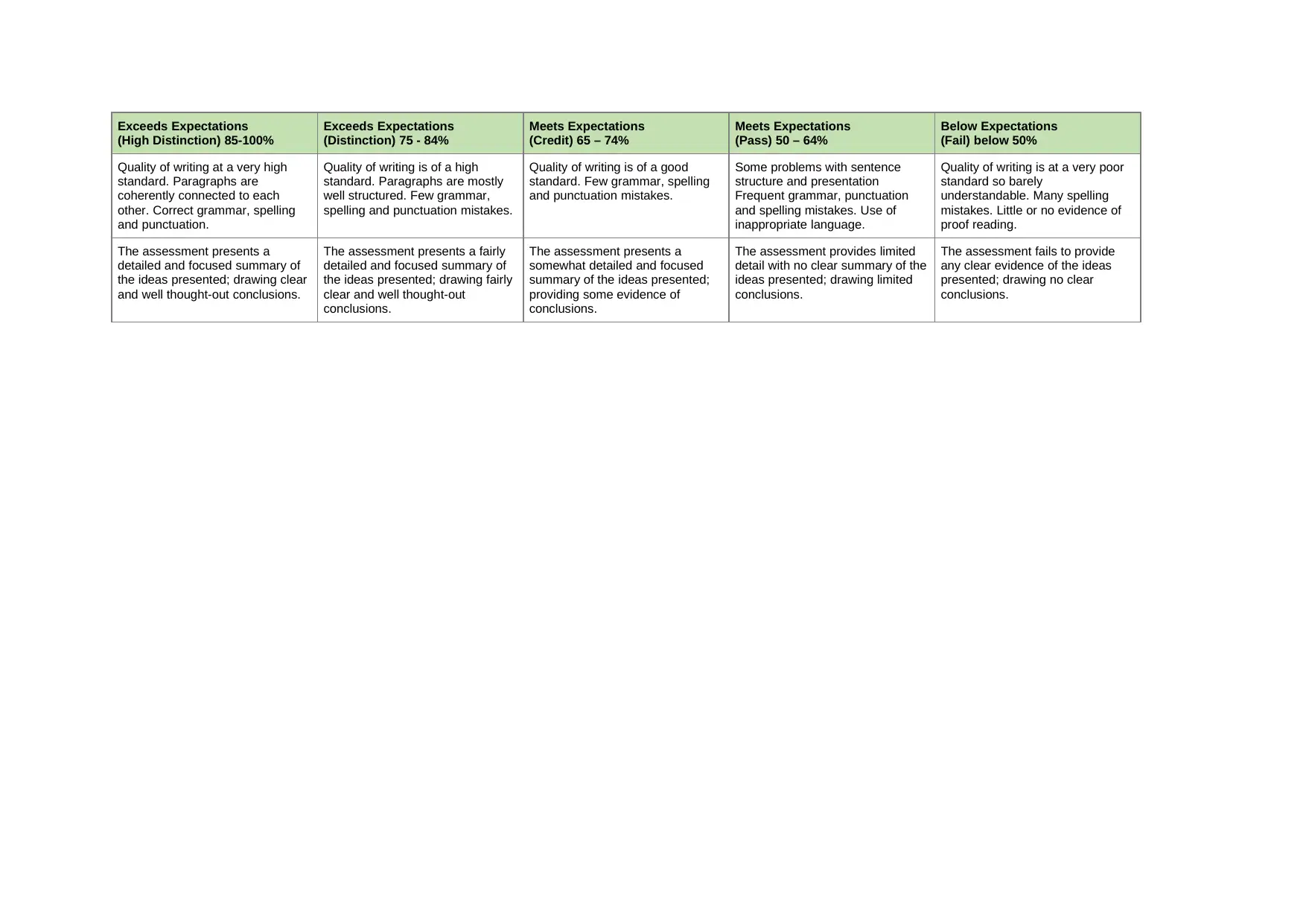
Exceeds Expectations
(High Distinction) 85-100%
Exceeds Expectations
(Distinction) 75 - 84%
Meets Expectations
(Credit) 65 – 74%
Meets Expectations
(Pass) 50 – 64%
Below Expectations
(Fail) below 50%
Quality of writing at a very high
standard. Paragraphs are
coherently connected to each
other. Correct grammar, spelling
and punctuation.
Quality of writing is of a high
standard. Paragraphs are mostly
well structured. Few grammar,
spelling and punctuation mistakes.
Quality of writing is of a good
standard. Few grammar, spelling
and punctuation mistakes.
Some problems with sentence
structure and presentation
Frequent grammar, punctuation
and spelling mistakes. Use of
inappropriate language.
Quality of writing is at a very poor
standard so barely
understandable. Many spelling
mistakes. Little or no evidence of
proof reading.
The assessment presents a
detailed and focused summary of
the ideas presented; drawing clear
and well thought-out conclusions.
The assessment presents a fairly
detailed and focused summary of
the ideas presented; drawing fairly
clear and well thought-out
conclusions.
The assessment presents a
somewhat detailed and focused
summary of the ideas presented;
providing some evidence of
conclusions.
The assessment provides limited
detail with no clear summary of the
ideas presented; drawing limited
conclusions.
The assessment fails to provide
any clear evidence of the ideas
presented; drawing no clear
conclusions.
(High Distinction) 85-100%
Exceeds Expectations
(Distinction) 75 - 84%
Meets Expectations
(Credit) 65 – 74%
Meets Expectations
(Pass) 50 – 64%
Below Expectations
(Fail) below 50%
Quality of writing at a very high
standard. Paragraphs are
coherently connected to each
other. Correct grammar, spelling
and punctuation.
Quality of writing is of a high
standard. Paragraphs are mostly
well structured. Few grammar,
spelling and punctuation mistakes.
Quality of writing is of a good
standard. Few grammar, spelling
and punctuation mistakes.
Some problems with sentence
structure and presentation
Frequent grammar, punctuation
and spelling mistakes. Use of
inappropriate language.
Quality of writing is at a very poor
standard so barely
understandable. Many spelling
mistakes. Little or no evidence of
proof reading.
The assessment presents a
detailed and focused summary of
the ideas presented; drawing clear
and well thought-out conclusions.
The assessment presents a fairly
detailed and focused summary of
the ideas presented; drawing fairly
clear and well thought-out
conclusions.
The assessment presents a
somewhat detailed and focused
summary of the ideas presented;
providing some evidence of
conclusions.
The assessment provides limited
detail with no clear summary of the
ideas presented; drawing limited
conclusions.
The assessment fails to provide
any clear evidence of the ideas
presented; drawing no clear
conclusions.
Paraphrase This Document
Need a fresh take? Get an instant paraphrase of this document with our AI Paraphraser
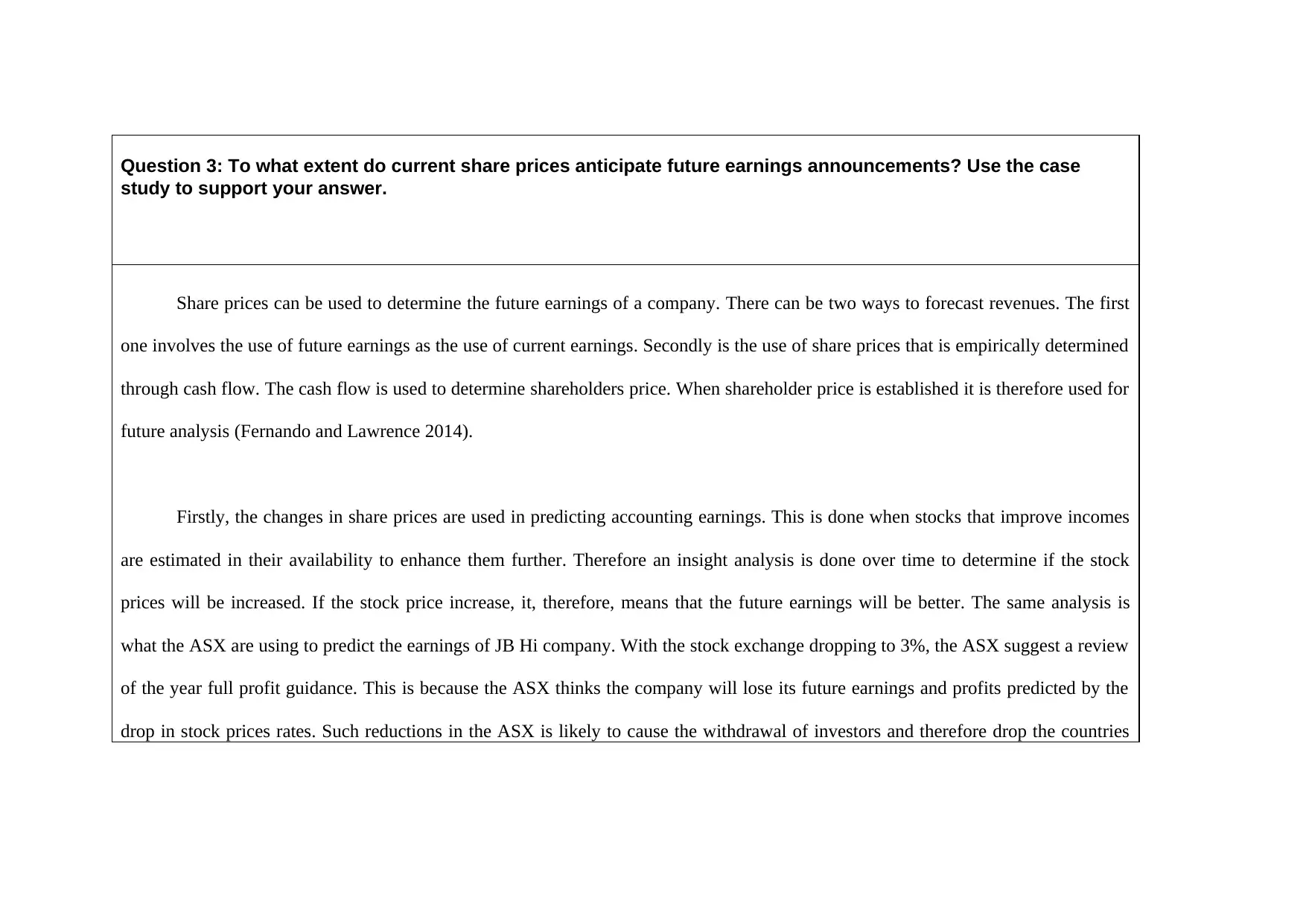
Question 3: To what extent do current share prices anticipate future earnings announcements? Use the case
study to support your answer.
Share prices can be used to determine the future earnings of a company. There can be two ways to forecast revenues. The first
one involves the use of future earnings as the use of current earnings. Secondly is the use of share prices that is empirically determined
through cash flow. The cash flow is used to determine shareholders price. When shareholder price is established it is therefore used for
future analysis (Fernando and Lawrence 2014).
Firstly, the changes in share prices are used in predicting accounting earnings. This is done when stocks that improve incomes
are estimated in their availability to enhance them further. Therefore an insight analysis is done over time to determine if the stock
prices will be increased. If the stock price increase, it, therefore, means that the future earnings will be better. The same analysis is
what the ASX are using to predict the earnings of JB Hi company. With the stock exchange dropping to 3%, the ASX suggest a review
of the year full profit guidance. This is because the ASX thinks the company will lose its future earnings and profits predicted by the
drop in stock prices rates. Such reductions in the ASX is likely to cause the withdrawal of investors and therefore drop the countries
study to support your answer.
Share prices can be used to determine the future earnings of a company. There can be two ways to forecast revenues. The first
one involves the use of future earnings as the use of current earnings. Secondly is the use of share prices that is empirically determined
through cash flow. The cash flow is used to determine shareholders price. When shareholder price is established it is therefore used for
future analysis (Fernando and Lawrence 2014).
Firstly, the changes in share prices are used in predicting accounting earnings. This is done when stocks that improve incomes
are estimated in their availability to enhance them further. Therefore an insight analysis is done over time to determine if the stock
prices will be increased. If the stock price increase, it, therefore, means that the future earnings will be better. The same analysis is
what the ASX are using to predict the earnings of JB Hi company. With the stock exchange dropping to 3%, the ASX suggest a review
of the year full profit guidance. This is because the ASX thinks the company will lose its future earnings and profits predicted by the
drop in stock prices rates. Such reductions in the ASX is likely to cause the withdrawal of investors and therefore drop the countries
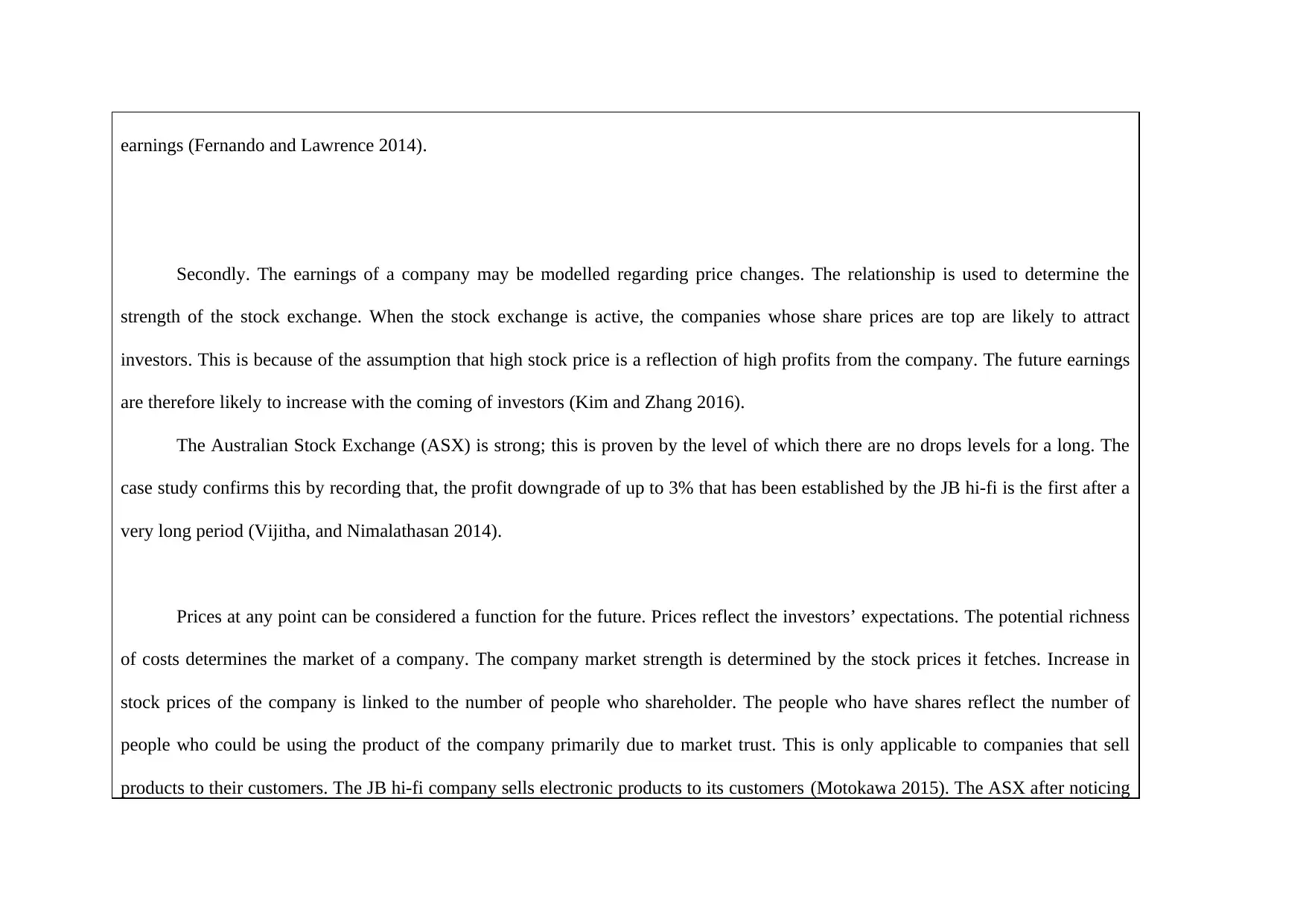
earnings (Fernando and Lawrence 2014).
Secondly. The earnings of a company may be modelled regarding price changes. The relationship is used to determine the
strength of the stock exchange. When the stock exchange is active, the companies whose share prices are top are likely to attract
investors. This is because of the assumption that high stock price is a reflection of high profits from the company. The future earnings
are therefore likely to increase with the coming of investors (Kim and Zhang 2016).
The Australian Stock Exchange (ASX) is strong; this is proven by the level of which there are no drops levels for a long. The
case study confirms this by recording that, the profit downgrade of up to 3% that has been established by the JB hi-fi is the first after a
very long period (Vijitha, and Nimalathasan 2014).
Prices at any point can be considered a function for the future. Prices reflect the investors’ expectations. The potential richness
of costs determines the market of a company. The company market strength is determined by the stock prices it fetches. Increase in
stock prices of the company is linked to the number of people who shareholder. The people who have shares reflect the number of
people who could be using the product of the company primarily due to market trust. This is only applicable to companies that sell
products to their customers. The JB hi-fi company sells electronic products to its customers (Motokawa 2015). The ASX after noticing
Secondly. The earnings of a company may be modelled regarding price changes. The relationship is used to determine the
strength of the stock exchange. When the stock exchange is active, the companies whose share prices are top are likely to attract
investors. This is because of the assumption that high stock price is a reflection of high profits from the company. The future earnings
are therefore likely to increase with the coming of investors (Kim and Zhang 2016).
The Australian Stock Exchange (ASX) is strong; this is proven by the level of which there are no drops levels for a long. The
case study confirms this by recording that, the profit downgrade of up to 3% that has been established by the JB hi-fi is the first after a
very long period (Vijitha, and Nimalathasan 2014).
Prices at any point can be considered a function for the future. Prices reflect the investors’ expectations. The potential richness
of costs determines the market of a company. The company market strength is determined by the stock prices it fetches. Increase in
stock prices of the company is linked to the number of people who shareholder. The people who have shares reflect the number of
people who could be using the product of the company primarily due to market trust. This is only applicable to companies that sell
products to their customers. The JB hi-fi company sells electronic products to its customers (Motokawa 2015). The ASX after noticing
⊘ This is a preview!⊘
Do you want full access?
Subscribe today to unlock all pages.

Trusted by 1+ million students worldwide
1 out of 22
Related Documents
Your All-in-One AI-Powered Toolkit for Academic Success.
+13062052269
info@desklib.com
Available 24*7 on WhatsApp / Email
![[object Object]](/_next/static/media/star-bottom.7253800d.svg)
Unlock your academic potential
Copyright © 2020–2025 A2Z Services. All Rights Reserved. Developed and managed by ZUCOL.



